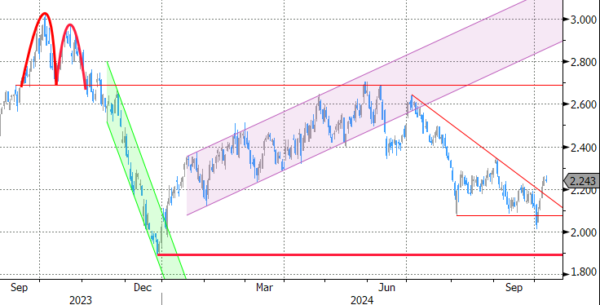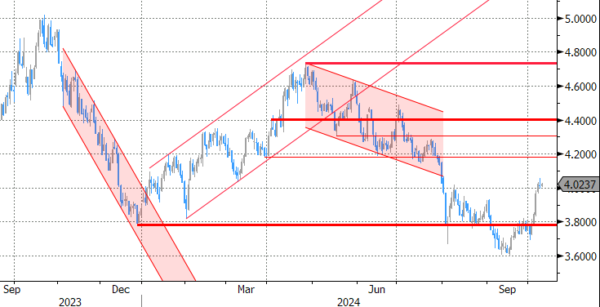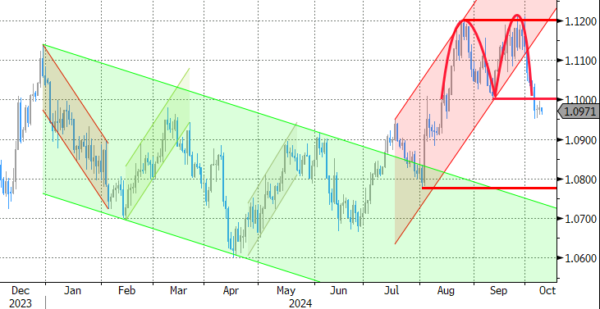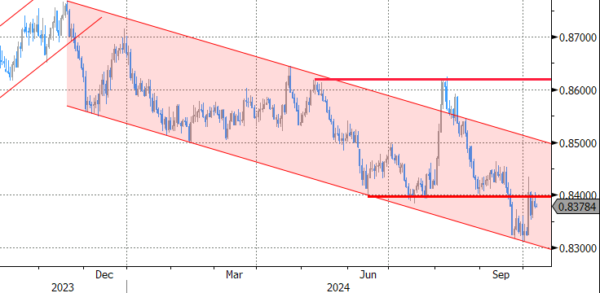Markets
The post payrolls rise in US yields and by extension in yields on other core markets yesterday shifted into a lower gear. Uncertainty whether China (fiscal and monetary) stimulus would be able to kickstart a genuine reacceleration of Chinese growth also left European markets with a risk-off start and modestly lower yields. Sentiment temporarily changed in the US, with yields trying to fight back early in US dealings. The $58 3-y Note action tailed slightly and other metrics also suggested guarded investors interest even after recent sharp rise in yields. Afterall, the impact on the market was limited. At the end of the day, US yields in technical trading eased between 3.7 bps (2-y) and 1.1 bp (30-y). Fed speakers including board member Jefferson repeated that risks to the Fed dual mandate of price stability and maximum employment have been roughly brought into balance. Decisions on further easing will be made on a data-dependent, meeting by meeting approach. Bost Fed president Collins took gave a similar assessment, but apparently is giving a bit more weight to the Fed supporting favourable economic conditions and not putting unnecessary restraint on demand. Aside from market policy expectations, an intraday decline of the oil price maybe also helped to cap the rise in US yields. Moves in German yields were modest (2-y -1.9 bps, 30-y +0.2 bps) as markets see the debate on to additional 25 bps cuts this year as ‘settled’. US equities ignored the China-driven uncertainty data weighted on European indices (S&P 500 +0.97, Nasdaq + 1.45%). The dollar maintained its post-payrolls gains, but nothing more than that (DXY 102.55, EUR/USD even marginally higher at 1.098). After some intraday volatility, sterling gained modestly against the euro (EUR/GBP 0.848) and the dollar (1.3104), but uncertainty on the UK fiscal situation/end October budget might hamper sustained further gains.
This morning, mainland China indices (CSI 300 -3.0%) suggest ongoing market doubts of the efficacy and the amount of stimulus from both monetary and fiscal authorities. Even so, spill-over effects to other regional markets stay limited. US yields are marginally higher. The dollar shows no clear trend (EUR/USD 1.097). Later today, there are no important eco data in Europe or the US. The US Treasury will sell $39 bln US 10-y Notes. Investors will also keep an eye at the Fed minutes of the September 17-18 meeting. Officially there was only one dissenting vote (Michelle Bowman) on the 50 bps rate cut, but especially given the strong payrolls report Friday, markets will look for other MPC members making reservations on the bold start of the easing cycle. For now we expect yields to hold near current levels in the run-up to tomorrow’s US CPI data. The technical picture on the dollar improved (e.g. EUR/USD below 1.1002 neckline), but for now there is no convincing trigger to extend further USD gains.
News & Views
The Reserve Bank of New Zealand cut its policy rate for a second consecutive time this morning, upping the pace from an inaugural 25 bps to 50 bps today. The Official Cash Rate now stands at 4.75% which the RBNZ still sees as being restrictive, leaving monetary policy well-placed to deal with any near-term surprises. The central bank sticks with a data-dependent approach going forward. At the next meeting, a new set of economic forecasts will be available. Money markets discount another 50 bps rate cut. Headline CPI is expected to be withing the 1%-3% target band in Q4 2024 and to remain around the midpoint in the medium-term. Weak demand is restricting the pass-through of increased input costs to prices faced by consumers. Apart from weak consumer growth, also weak business investments and low productivity growth slow the economy. Employment conditions continue to soften. The kiwi dollar extends this month’s losses against a reviving dollar with NZD/USD currently changing hands at 0.61 coming from levels around 0.6350 at the end of Q3.
The US federal budget deficit was $1.8tn in fiscal year 2024 (about 6.4% of GDP) according to estimates by the Congressional Budget Office. That’s $139bn more than the official shortfall recorded during fiscal year 2023. If not for the Supreme Court’s decision to overturn a plan to cancel many borrowers’ outstanding student loans, the 2023 deficit would have been $2tn. Revenues increased over the past year by an estimated $479bn (or 11% to $4.92tn). Outlays rose by an estimated $617bn (or 10% to $6.75tn). The US spent $950bn on interest, up 34% from the prior year, mostly because of higher interest rates. Interest costs surpassed military spending.
Graphs
GE 10y yield
The ECB cut policy rates by 25 bps in June and in September. Stubborn inflation (core, services) still is a source of concern, but very weak PMI’s and soft comments of Lagarde (and other MPC members) suggest the ECB is likely to step up the pace of easing with an October cut. Spill-overs from strong US data prevented a test of the 2.0% barrier. 2.00-2.35% might serve as a ST consolidation range.
US 10-y yield
The Fed kicked off its easing cycle with a 50 bps move. The Fed shifting focus from inflation to a potential slowdown in growth/employment made markets consider more 50 bps steps. Strong US September payrolls suggest the economy doesn’t need aggressive Fed support for now, but the debate might resurface as the economic cycle develops. For the US 10-y, 3.60% serves as strong support. The steepening trend is taking a breather.
EUR/USD
EUR/USD moved above the 1.09 resistance area and twice tested the 1.12 big figure as the dollar lost interest rate support at stealth pace. Bets on fast and large rate cuts trumped traditional safe haven flows into USD. An ailing euro(pean economy) partially offset some of the general USD weakness. After solid early October US data, the dollar regained traction, with EUR/USD breaking the 1.1002 neckline. Targets of this pattern are near 1.08.
EUR/GBP
The BoE delivered a hawkish cut in August. Policy restrictiveness was indicated to be further unwound gradually. The economic picture between the UK and Europe also was increasingly diverging to the benefit of sterling, pulling EUR/GBP below 0.84 support. Dovish comments by BoE Bailey ended by default GBP-strength.
















